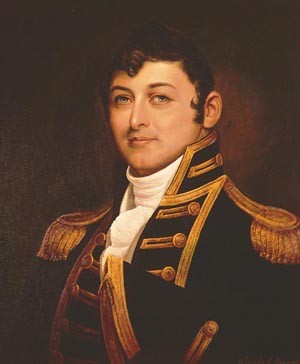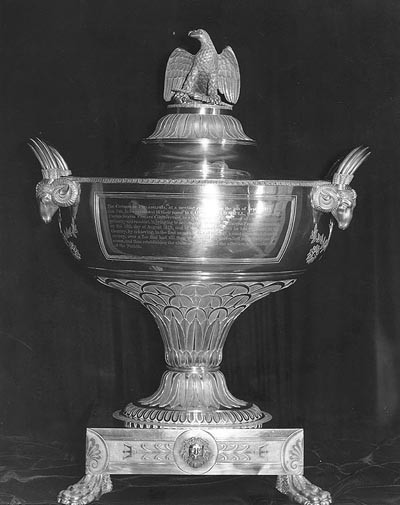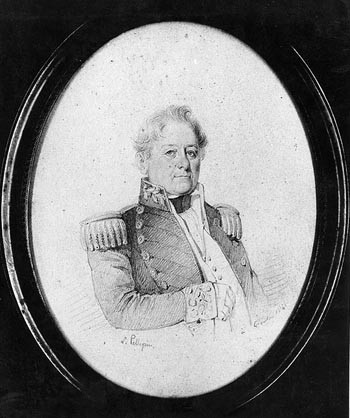Bibliography
Chronology of Service
Documents in the Navy Department Library
USS Hull [first], [second], [third], [fourth] histories
Biography
Naval officer Isaac Hull was born in Derby, Connecticut, 9 March 1773, son of Joseph Hull, and nephew of General William Hull, the revolutionary officer. His earliest American ancestor was Richard Hull, of Derbyshire, England, a freeman of Dorchester, Massachusetts, in 1634, whence he removed to New Haven, Connecticut five years later, “because he would not endure Puritanism.” He was a representative to the general court of Connecticut, and died in September 1662. The line of descent runs through Richard’s son, Dr. John Hull (1640-1711), who in 1668 was one of the original twelve settlers of Pawgassett, now Derby, Connecticut, where he built the first parsonage and meeting-house, was selectman, and a member of the general assembly; through his son, Captain Joseph (1668-1744), also a representative to the general assembly and owner of large business interests in Derby, who was married in 1691 to Mary Nichols; their son Captain Joseph (1694-1778) and his wife Sarah Bennett and their son, Captain Joseph (1728-1775), and his wife Elizah Clark, who were the commodore’s grandparents.
His father, the fourth Joseph Hull, was a lieutenant of artillery in the Revolutionary War, and greatly distinguished himself in the defence of Fort Washington, where he was captured. He was exchanged in 1778 and re-entering the army was given command of a flotilla on Long Island Sound, consisting of several whale boats fitted out to annoy the enemy. On one occasion, with twenty men, in a small sloop, he captured a British armed schooner off Derby. He engaged early in life in the West India trade, and later in whale fishing, and in this practical school his son Isaac took his first lessons in seamanship. The father died from the effects of the cruel treatment inflicted by the British in the prison ship Jersey, and Isaac was adopted by his uncle, General William Hull.
The latter wished to give him a collegiate education, but the plan miscarried, owing to his unconquerable passion for the sea, and at the age of fourteen years he became cabin boy in a merchant ship. It is related that the vessel was shipwrecked some two years later, and young Hull saved the captain’s life by supporting him in the water until they reached shore.
In 1793 he was placed in command of a ship sailing to the West Indies, and while in this position gained such a reputation as a skillful mariner that upon the organization of the United States navy he was commissioned fourth lieutenant, 9 March 1798, and was assigned to the frigate Constitution. He served on that vessel two years, first under Commodore Samuel Nicholson, and then under Commodore Silas Talbot, having been promoted first lieutenant in 1799.
While cruising off Santo Domingo Captain Talbot ascertained that a valuable French letter-of-marque the Sandwich was about to leave Puerto Plata, Santo Domingo, and fearing he would not be able to capture her if she once got to sea, sent Lieutenant Hull to cut her out. Taking the sloop Sally, Hull successfully boarded the Sandwich and in a few minutes secured her, while part of his force surprised the battery on shore and spiked the guns before effectual resistance could be made. “This gallant affair was conducted with much steadiness,” writes Edgar Stanton Maclay, “and reflects the highest credit on Lieutenant Hull, but the seizure was illegal as Captain Talbot learned on arrival in port and the Sandwich was returned with full compensation for losses.”
He was promoted master commandant, 19 May 1804, and as commander of the brig Argus participated with Commodore Edward Preble’s Mediterranean squadron in the war against the Barbary States. He was made captain in 1806.
In 1811, while in command of the Constitution, he was ordered to convey Joel Barlow, the newly-appointed minister to France, and to carry specie to Holland to pay the interest on the debt due from the United States. After dispatching this business he proceeded to Portsmouth, England, in order to communicate with the legation in London, and while in this port, an incident occurred indicative of the aggression and belligerent spirit of the British, which shortly resulted in the war of 1812.
Late one night a British officer came aboard with the information that an American deserter was on the British man-of-war Havana, and that he would be given up when desired. When a boat was sent for him it was stated that the deserter claimed to be a British subject and so would not be given up. Shortly thereafter a British deserter from the Havana swam to the Constitution and on being asked his nationality replied that he was an American. The tables were now turned, and when the British sent a boat for him Lieutenant Charles Morris, in the absence of Captain Hull, refused to surrender him, giving the same reason that had been offered for not giving up the American deserter.
This refusal aroused much angry comment on the part of the British: threats to use force were freely expressed, and two British frigates bore down on the Constitution and anchored so close that it was almost impossible to get away without fouling them. When, on the following day, Hull sailed for Cherbourg, France, several men-of-war were seen in chase, but the Constitution outsailed all except one, and upon gaining a safe distance she hove to, beat to quarters, and waited to learn the Englishman’s intentions. The man-of-war sailed close to the Constitution but no hostilities were offered, and after exchanging a few common-place hails stood about on a different course. Soon after, war with Great Britain was declared, the Constitution was cleaned and coppered at Annapolis, and ordered to join the squadron of Commodore Rodgers at New York.
She sailed from Annapolis 12 July 1812, and on the 17th fell in with a small blockading squadron under Captain Broke, when one of the most remarkable sea chases ever recorded occurred. On the following day there was a dead calm, and the Constitution as well as the English vessels drifted independent of their helm. Hull launched and manned the boats to tow; all the light canvas that would draw was set, and soon he was slowly moving away in a manner that puzzled his pursuers. Every effort that ingenuity and experience could suggest was made to increase the Constitution’s headway. The sails were wet to make them hold better whenever wind might come, and even the hammocks were removed from their hangings and the clothes rolled up to prevent unfavorable action. At length the British discovered the secret, and thereupon their ships were urged onward by the same means.
At the suggestion of Lieutenant Morris kedging was now tried, and by this means and by towing, the pursuit continued for another day and night. At sunset on 19 July a squall struck the American frigate, and Hull determined on a stratagem by which he hoped to make his escape. All the light sails were furled, a double reef was put in the top-sail and every preparation was made as if for a heavy blow. Observing these precautions, the English commanders supposed, as Hull judged they would, that a squall of unusual violence was approaching, and they began shortening sail and bore up before the wind, which headed them in an opposite direction for the Constitution. The squall as Captain Hull could see was light, and as soon as the rain shut in his vessel from the enemy’s view he made sail, and was soon fleeing from his pursuers at the rate of eleven knots an hour. At midnight the British fired two guns, and the next morning gave up the pursuit, which had lasted sixty-six hours.
On reaching Boston, Captain Hull was given a public reception, the newspapers were filled with praises of him and his ship, and the English themselves paid a high tribute of admiration to his indomitable and skillful seamanship. The British newspapers, sneering at the American Navy, had spoken of the Constitution as “a bundle of pine boards sailing under a bit of striped bunting,” and had also declared that “a few broadsides from England’s wooden hulls would drive the paltry striped bunting from the ocean.”
Hull was eager to pluck out the sting of these insults, and fearing that the timid policy of the Navy Department might detain him in port, sailed from Boston 2 August 1812. A few days later instructions arrived in that city for him “to remain in port until further orders.” “Had the Constitution been captured on this cruise,” remarked Rear-Admiral Bell, “Hull would have been hanged or shot for sailing without orders.”
Reaching the bay of Fundy, he cruised eastward of Nova Scotia, where he captured a number of British vessels and on the afternoon of 19 August fell in with the British frigate Guerriere, Captain Dacres. Some firing began long range, but Hull soon discontinued it and pressed sail to get his vessel alongside. When the Guerriere began to pour shot into the Constitution, Lieutenant Morris, second in command, was impatient to reply to the attack, and several times asked permission to open fire, but was repeatedly restrained by Hull, notwithstanding that the shots began to tell on the Constitution.
When at last the vessels were very close, Hull, with intense excitement shouted, “Now, boys, pour it into them,” and his command was instantly obeyed. The guns of the Constitution were double-shotted with round and grape, and their execution was terrible. Fifteen minutes after the contest began the Guerriere’s mizzen-mast was shot away, her main-yard was in strings, and her hull, spars, sails and rigging were torn in pieces. The ships now grappled, and both parties attempted to board, but the sea was so rough and the musketry fire so deadly that this was found to be impossible. Soon after the vessels fell apart, the Guerriere’s main-mast fell into the sea, bringing down the fore-mast, and an enormous weight of yards and rigging. Captain Dacres reluctantly surrendered and too badly injured to be saved, the Guerriere was set on fire and blown up after her men were removed.
In several histories of the Navy, it is related that at an exchange of visits before the war, Captain Dacres made a wager of a hat with Captain Hull on the outcome of a possible meeting between their vessels. When the commander of the Guerriere came up the side of the Constitution on a rope ladder to surrender his sword, Captain Hull assisted him, saying: “Dacres, give me your hand. I know you are hurt,” and when the English commander offered his sword, Captain Hull replied: “No, no, I will not take a sword from a man who knows so well how to use it; but I’ll trouble you for that hat.”
In a paper on the life of Captain Hull, General James Grant Wilson said: “Captain Hull asked Dacres if there was anything in particular in the Guerriere which he wished to preserve. On his expressing a desire to save a large bible, the gift of his mother, Hull sent an officer for it. Many years later our hero met Dacres, then an admiral, in command of a squadron off Gibraltar. He expressed the greatest pleasure at meeting the commodore, and was constant in his courtesies and attentions. At a dinner given on board the flagship he showed Mrs. Hull the treasured bible her husband had saved. Dacres was deeply touched by Hull’s humane and generous treatment of himself and crew.”
This contest, the first frigate action of the war, won for the Constitution the name of “Old Ironsides’” because she came out of the action with so little injury. The Americans lost seven killed and seven wounded, while the enemy had fifteen killed and sixty-three wounded. The news of the victory was received with joy throughout the country, and upon her arrival in Boston the ship and all on board were welcomed with the greatest enthusiasm. The people of Boston gave Hull and his officers a banquet; the authorities of New York offered him the freedom of the city, and ordered a full-length portrait of him painted by Jarvis; other cities passed resolutions of thanks and presented their freedom; and several legislatures voted him a sword of honor. Congress awarded him a gold medal, and appropriated $50,000, to be distributed as prize-money among the officers and crew.
Resigning the command of the Constitution, Captain Hull became a member of the naval board. He subsequently had charge of the navy yards at Boston and Washington, commanded the squadrons in the Pacific and the Mediterranean, and the ship-of-the-line Ohio, flagship of the European squadron, during 1839-41, this being the last of his thirty-seven years of distinguished and faithful service afloat and ashore.
He was married in 1813 to Anna Hart, who survived him. After his retirement he made his home in Philadelphia, Pennsylvania, where he died 13 February 1843. His last words were “I strike my flag.”
Adapted from: The National Cyclopaedia of American Biography. Vol.13. New York: James T. White & Co., 1906. [See "Hull, Isaac" on pages 426-428.].
Chronology of Service
1798 9 March Appointed to USS Constitution as Lieutenant 6 July Commission as Lieutenant delivered 1801 8 July Ordered to remain on board USS Constitution 21 September Ordered to take charge of USS Constitution 1802 1 April Ordered to duty in USS John Adams 1803 Ordered to command of USS Enterprise Ordered to command USS Argus 1804 18 May Promoted to Master Commandant 23 November Commission issued 1806 23 April Promoted to Captain 24 July Returned to the United States in Argus and ordered to Connecticut to contract for and superintend building of four gunboats 1807 9 January Commission as Captain issued 26 June Ordered to Hampton, Virginia, to act as member of a Court of Inquiry 11 July Ordered to Norfolk under Commodore Decatur 12 September Appointed member of Board of Inquiry 1809 11 January Ordered to duty in USS John Adams 2 February Ordered to Norfolk for duty in USS Chesapeake 15 April Ordered to take command of Portland Station in addition to other duties 1812 10 October Ordered to command at New York 12 November Ordered to Washington 1813 Ordered to command of Boston Navy Yard Ordered to command of Portsmouth Navy Yard 1814 18 January Granted short leave of absence 21 January Ordered to report to Commodore Bainbridge at Charleston, SC 1815 Appointed to Board of Navy Commissioners 1824-1827 Commodore of Pacific Squadron - Flagship United States 1829-1835 Commanded Washington Navy Yard 1833 Commanded USS Constitution 1835 On leave 1838 Appointed Commodore of Mediterranean Squadron - Flagship Ohio 1841 Retired 1843 Died in Philadelphia, Pennsylvania
Source: "Isaac Hull, USN" (single-page undated typed chronology covering 1798-1814) and other items in Isaac Hull ZB file, Navy Department Library.
Documents in the Navy Department Library:
1) Autographed Letter Signed (ALS) dated 12 May 1819, Boston. To Samuel Dana, Esq., Middletown, Connecticut. Concerning Hull's finances.
2) ALS dated 4 June 1819, at the "Navy Yard." To Commodore Bainbridge. Regarding a "74 now building in the yard."
3) 6 ALS while on the frigate United States. All to William Tudor, U.S. Consul to Peru.
a) 4 June 1824. Requests Tudor's opinion on papers relative to the "blockade."
b) 18 June 1824. Tells Tudor that situation for U.S. citizens is getting tense. He recommends they come aboard United States.
c) 12 October 1824. Requests Tudor to come aboard.
d) 10 July 1826, Callao Bay. Reports he has read Tudor's letter about armed seizure of American merchantman Herald and proposes to provide American merchants with assistance for their defense.
e) 19 July 1826, Callao Bay. More on the subject of Herald.
f) 19 November 1826, Callao Bay. Tells Tudor that reports that Jefferson and Adams are dead are true; that a salute shall be fired and flags lowered to half mast "this day at 12 o'clock."
4) ALS dated "Tuesday, 23rd" (no month, no year), Boston. To Thomas Chew, Esq., USN. Congratulates Chew on obtaining a Washington assignment and thanks him for inquiring about Hull's health.
5) Two journals by Augustus R. Strong, Journal of a cruise from Norfolk, Virginia, to the Pacific Ocean, in the United States frigate United States, Isaac Hull, esq’r, commander. 1824 and 1825.
Use and Reproduction Policy: These manuscript materials are unavailable for loan and must be consulted in the library. Photocopying of manuscripts, as well as fragile items, is generally prohibited, though the use of digital cameras (without flash) by researchers is permitted.







